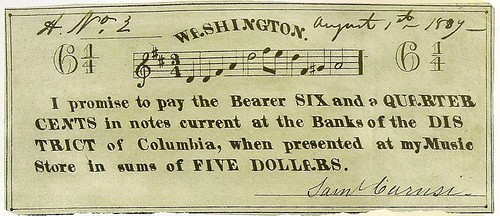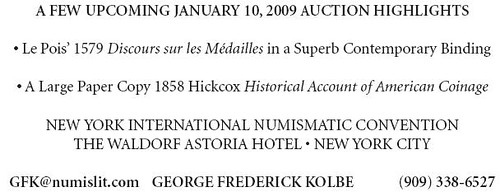
PREV ARTICLE
NEXT ARTICLE
FULL ISSUE
PREV FULL ISSUE
V11 2008 INDEX
E-SYLUM ARCHIVE
BOOK REVIEW: AMERICAS MONEY, AMERICAS STORY BY RICHARD DOTY
E-Sylum reader Carl Honore, M.A. provided the following
review of the new second edition of Richard Doty's Americas Money,
Americas Story, published by Whitman Publishing. -Editor
 Richard Doty, head curator of the National
numismatic collection at the Smithsonian Institution has written the
second edition of his observations on the history of Americas
money.
Richard Doty, head curator of the National
numismatic collection at the Smithsonian Institution has written the
second edition of his observations on the history of Americas
money.From the beginnings of our economic symbols from wampum up through our bullion coins, Mr. Doty has kept the reader informed and entertained in his inimitable style. The reader is treated to an account of attempts to counterfeit wampum by staining it with berry juice! In another section, the reader is informed that the leaf prints on Americas first paper money were actually a counterfeit deterrent, as the skeletons of leaves are much like fingerprints. Each is unique. This thread of the history of counterfeiting is one theme that weaves its way through the history of our money up to the colorization of todays paper denominations. It would seem in conclusion that everything old is new again.
In and among these anecdotes are tidbits of information such as the various items that were traded monetarily. These include tobacco, (providing one could corner the market and thus control the production of this noxious plant), nails, and the like. All of these have a place in the history of Americas money and the point is made that all of these are just as important as the coins and paper money that literally rolled out of the mint.
Doty goes on to mention the cause and effect of various money manufacturing methods. He makes these rather mundane subjects quite fascinating. One section of this updated volume is devoted to the paper money technology of Jacob Perkins. (I will spare the details here so that there can be something to look forward to when one purchases this book.) Suffice it to say here that this section is worth the whole price of this volume.
Along with the pictures and vignettes of the various coins and specimens of paper money, Doty presents a concise history of banking in America and discusses the various economic upturns and downward spirals in our monetary history. One can hardly discuss the money of our country without discussing the economy tied in with its manufacture.
One aspect of our monetary history that is missing, from this readers standpoint at least, is a discussion of the devaluation of our basic coinage, beginning in 1795 when the large cent and half cent were made half as thick. Half the copper was taken out, again as a result of the world market for copper. Copper was devalued on the world market and so our coins were thinned out Again devaluation would take place in 1856 with the tiny (by comparison) flying eagle cent, and yet again in 1981 when the cent was made of copper coated zinc! Such mention of this devaluation reflective of the cost of metal on the world market and its effects on our hobby would have made this volume perhaps a bit more complete.
Doty has made history an exciting subject for any reader with his presentation of this subject as illustrated by Americas coins and paper money. The budding numismatist will find his or her newfound interest in our money more enriched by reading this volume. The more seasoned collector will find a wealth of information at the fingertips.
The illustrations show Americas money at its collective best. The balance between illustration and text is maintained quite well; one does not overly detract from the other, but rather each augments the understanding of the other.
There is something for everyone in this book, whether the person reading is an appreciator of fine art, a historian, or a technology buff.
In short, this book celebrates Americas rich monetary history even during this period of economic downturn. It is highly recommended even for non numismatists.
I'll add my own brief thoughts to note that the production
by Whitman is superb, making the book a splendid read. The illustrations
are a delight. Among my favorites are the 1837 scrip notes of a District
of Columbia music store.

The book abounds with delightful image choices, including typewritten 1933 New York depression scrip and the Pismo Beach clamshell dollar. It's not just a pretty picture book, though - the text is excellent, making this another one of the select few numismatic books that aren't just for reference, but for actually sitting down and reading. -Editor

The book abounds with delightful image choices, including typewritten 1933 New York depression scrip and the Pismo Beach clamshell dollar. It's not just a pretty picture book, though - the text is excellent, making this another one of the select few numismatic books that aren't just for reference, but for actually sitting down and reading. -Editor

Wayne Homren, Editor
The Numismatic Bibliomania Society is a non-profit organization promoting numismatic literature. See our web site at coinbooks.org.
To submit items for publication in The E-Sylum, write to the Editor at this address: whomren@gmail.com
To subscribe go to: https://my.binhost.com/lists/listinfo/esylum
All Rights Reserved.
NBS Home Page
Contact the NBS webmaster
